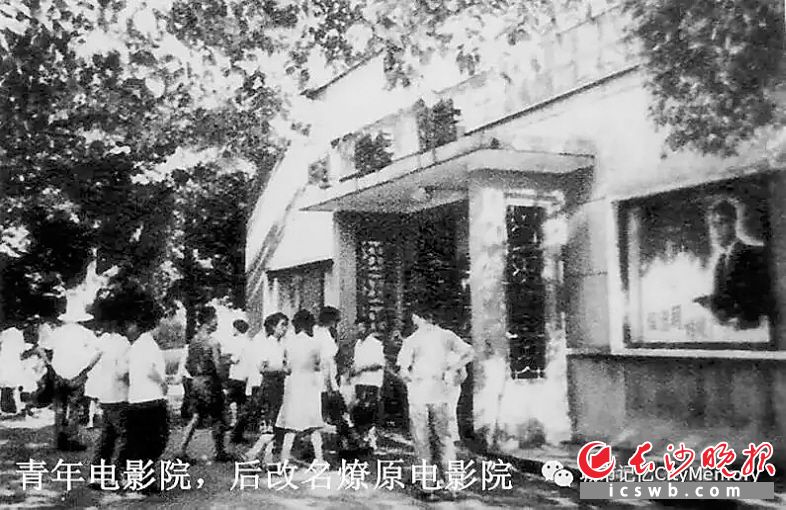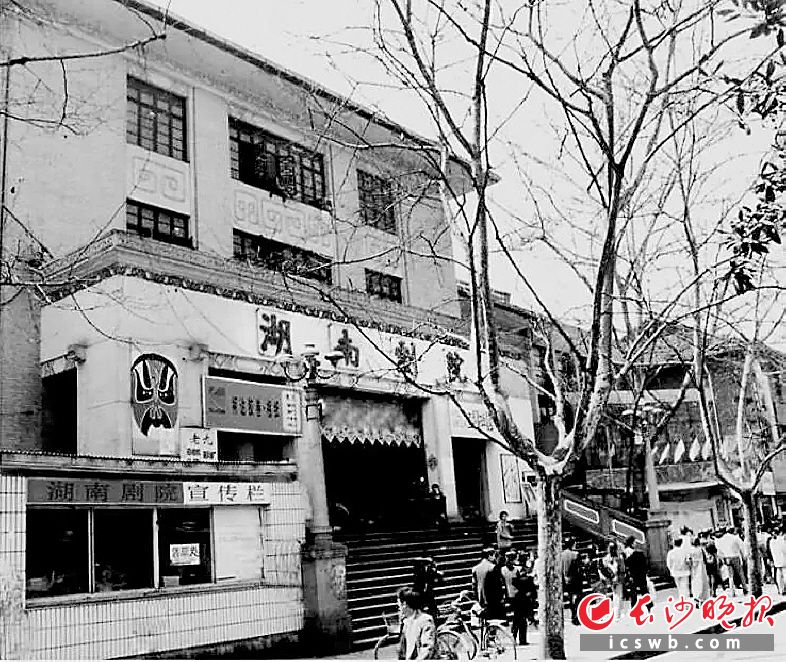
The Youth Cinema, once located in Huangxing Road. Information picture

Hunan Theatre used to be on Wuyi Road. Information picture
Wei ou
There were only about 10 or 20 cinemas in Changsha in the 1970s and 1980s. As a movie fan, I spent a lot of my spare time in these cinemas. At that time, the price of movie tickets was generally between a dime and a triangle, and our pocket money was still affordable.
Dongfeng Theater, My Spiritual Paradise
The nearest cinema to my home is Dongfeng Theatre. At that time, the Dongfeng Theater was still very magnificent. It had two gates, the east gate and the south gate. On the eaves of the south gate stood four big red signs of the Dongfeng Theater. From the two gates, they climbed a few low steps and each had a small hall for everyone to rest when waiting for the movie.
There are so many movies I have seen in Dongfeng Theatre that I can’t remember them clearly. I remember one year when the martial arts film Wu Linzhi was released, it was hard to get a ticket. I was still in junior high school and wanted to see it very much. I had to wait at the door with 23 cents to see if there was a refund. The weather was bad that day, and it was windy and rainy. Poor me, I was too small to touch the edge. Another time, one night when I was in senior three, a martial arts film "Heroes Out of Teenagers Since Ancient Times" was being shown here. I don’t know if more than a dozen students in our class ate Xiong Xin leopard gall or something, but they all went to the movies together. The film was still on, only to hear "the teacher is coming".
We were so scared that we all got under the seats one by one.
Dongfeng Theater, later changed to Dongfeng Film and Television City, has now become Mango Studios. It is one of the few places in Changsha that has been preserved since the 1970s and 1980s and has been used as a cinema.
Silver Palace Cinema was once the most advanced cinema in Changsha.
The Yingong Cinema on Zhongshan Road is also a cinema that we often visit. It is located next to the old Zhongshan Department Store, and its yard is the auditorium attached to the China Goods Exhibition Hall built in 1931. It was originally named Yingong Cinema, and famous Peking Opera artists Mei Lanfang and Ma Lianliang all performed here. In March l935, it was transformed into a cinema with the best screening facilities in the province. After 1951, it was renamed "Xinhua Cinema", and in 1988, it was transformed into the first 70 mm stereo cinema in the province, and the original name of "Silver Palace" was restored. Yingong Cinema has many first titles of Changsha movies: it is the first cinema in Changsha to fully play audio movies, the first one to play color movies and the first one to play stereo movies.
During the period when the Silver Palace was also called Xinhua Cinema, the courtyard was divided into two floors, and there were two rotating stairs for going up and down the stairs on the left and right sides of the lobby on the first floor. At that time, the cushion of the seat was movable, one side was leather, which could be turned over in summer, and the other side was bamboo, which made it cool to sit. After 1988, a stepped chair with high back and soft seats, an 18-meter-wide huge screen and a high-fidelity stereo were built here, which made people feel immersive when watching movies.
I have seen many movies here, such as Aurelian, Walter Defending Sarajevo, Escape from Danger, Break Dance, True Lies, Titanic and so on. I was still in primary school when I watched Aurelian. It was the first time that I went to the cinema alone.
From the Silver Palace to the west for a hundred meters, across the road is the Red Theater, which was built in 1957. Before the Cultural Revolution, the Red Theater only acted, but didn’t show movies. It didn’t start to show movies and play dramas until the 1970s. Besides many movies, we have seen many performances here. Although "red" is still there, there is no film showing.
Further west from the "red" is Changsha Youth Palace, which was opened to the public in 1958 and also has a cinema. I remember that in the 1980s and 1990s, there were not only movies here, but also the main place for the convention in Changsha. Especially on Children’s Day on June 1st every year, there will be a commendation meeting for outstanding miyoshi students in the city. In November 2013, Changsha Youth Palace officially started the demolition and reconstruction project, and the old Youth Palace cinema ceased to exist.
Liaoyuan Cinema, the earliest cinema in Changsha.
Coming out of the Youth Palace and passing the Zhongshan Pavilion, there was a prairie fire cinema at the intersection of Jixiang Street and Chunfeng Street on the most prosperous Huangxing Road at that time. Before liberation, it was the Changsha YMCA, so it was called the Youth Cinema. The Youth Cinema opened in 1914, which is the first cinema in Changsha. It uses the church as a projection hall, mainly to show religious films, as well as feature films, such as "Jewelry Case". During the Cultural Revolution, the Youth Cinema was changed to the Liaoyuan Cinema, which was divided into two venues, an indoor cinema and an open-air cinema. The open-air cinema was once transformed into a ballroom and a foot-washing city, and it became a famous Dragon City Entertainment City, which was once famous for a while, and then it was transformed into a wholesale market. Indoor cinemas are now rented rooms.
Hunan Theater, once the best theater in Hunan.
There used to be a famous "Hunan Theater" in the southwest corner of Wuyi Square, which is now the location of Jinjiang East.
Its predecessor was Lianhua outdoor cinema in Yichang Street, Changsha in the 1940s. In 1947, the Sixth Anti-Japanese Theater Team, known as the "literary light cavalry" in War of Resistance against Japanese Aggression, moved from Wuhan to Changsha, where it joined the Fourth Theater Team, which had arrived in Changsha earlier, and built the Lianhua Theater. In 1954, Wuyi Road was built in Changsha, Lianhua Theatre was demolished and Hunan Theatre was built.
Hunan Theater was the best theater in Hunan at that time. The seats were cowhide, the decoration of the audience hall was antique, and there was a blower to extract the cold air from the basement to cool down. In addition to showing movies, there are often first-class performances at that time, such as symphony concerts, ballet, acrobatics and magic, Beijing opera and so on. After the completion of Hunan Theatre, the first foreign performing group was the Soviet art delegation. In 1956, Mei Lanfang came to Changsha to perform in Hunan Theatre.
At the beginning of the 21st century, Changsha expanded Wuyi Road and demolished Hunan Theater.
Those old cinemas in Changsha that dissipated with the wind
In the 1980s and 1990s, cinemas in Changsha were mostly concentrated in core blocks such as Zhongshan Road, Wuyi Road and Huangxing Road. At the beginning of the 21st century, with the large-scale urban construction, a large number of old cinemas have closed down, changed jobs or been demolished, and gradually disappeared in the depths of time.
The popular cinema is the location of Bandai Square now. Before liberation, it was called Guotai Cinema, which was converted into a popular amusement park in the 1950s, and only in the early 1960s was it converted into a popular cinema. "Volkswagen" was in the northwest corner of the most lively Wuyi Square in Changsha at that time. After watching the movie, it was a pleasant and fashionable pleasure for Changsha people to order a pot dumpling at Xiangqun, a milk bread at the milk shop and an iced sour plum soup at Hongmei.
Opposite to the popular cinema, that is, the southeast corner of Wuyi Square, there used to be a silver star cinema built before liberation, which was demolished in 1996 due to the construction of Pinghetang commercial building.
Jiefang Road, where there used to be a Jiefang Cinema and Changsha Theater, has disappeared. In Pozi Street, there used to be a Xiangjiang Theater diagonally opposite to the Fire Palace, and later it became a place for theatrical performances in Changsha and even Hunan, known as "Xiwozi", and now it has become one of the performance venues of Laughter Factory.
There is also a cultural cinema next to the headquarters of Changjun Middle School, and there are also famous time-honored Shuang Yan Wonton Restaurant, Guofeng and Nanbeite grocery stores nearby. There is also a branch of the Cultural Cinema, which is not far away, just on the Bixiang street corner of Shuyuan Road. It is a rented club venue of the Provincial Metallurgical Bureau.
Now there used to be a construction workers’ club next to the mobile phone market in Baonan Street, which used to be the location of Hunan Mud Carpenter Club. In 1956, it was transformed into a construction workers’ club, and in 1986 it was renamed the construction workers’ cultural palace. In 2017, it was completely demolished due to urban transformation.
There is also a cinema next to the west gate of Martyrs Park on Dongfeng Road, which has been demolished and turned into many hotels. I have also seen many movies here, among which the most impressive one is "Eternal Life in Fire" organized by the school in primary school.
There are also the seamen’s club cinema on the edge of Xiangjiang River on Wuyi Road, a cinema in the northeast corner of Wujialing Bronn overpass, the workers’ club in the northern suburbs of Simaochong, a small cinema in Xiaoxiang Film Studio, the old workers’ cultural palace cinema on Xiangchun Road and the Red Flag Theatre opposite Yali Middle School, which have also disappeared in the years.
Although some cinemas exist as architectural forms, they have also become eclipsed in today’s bizarre and fantastic cinema world. For example, the Workers’ Cultural Palace in Dong Tang, the Construction Cinema opposite the Second Xiangya Hospital on Renmin Road, and the Railway Workers’ Cultural Palace on May 1st Road.
Time flies like electricity, the years that can’t be seen clearly, and the past that can’t be erased are like a gust of wind. But those youthful and beautiful memories will always be treasured in my heart and will never disappear.